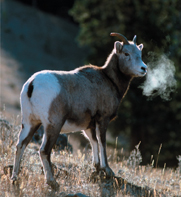Nutrient Cycles
 What is the importance of the main nutrient cycles?
What is the importance of the main nutrient cycles?
The chemical substances that an organism needs to sustain life are called nutrients.  Every organism needs nutrients to build tissues and carry out life functions. Like water, nutrients pass through organisms and the environment through biogeochemical cycles. The three pathways, or cycles that move carbon, nitrogen, and phosphorus through the biosphere are especially critical for life.
Every organism needs nutrients to build tissues and carry out life functions. Like water, nutrients pass through organisms and the environment through biogeochemical cycles. The three pathways, or cycles that move carbon, nitrogen, and phosphorus through the biosphere are especially critical for life.
Another element, oxygen, participates in parts of the carbon, nitrogen, and phosphorus cycles by combining with these elements and cycling with them through parts of their journeys. Oxygen gas in the atmosphere is released by one of the most important of all biological activities: photosynthesis. Oxygen is used in respiration by all multicellular forms of life, and many single-celled organisms as well.

Figure 3–16 Oxygen in the Biosphere The oxygen contained in the carbon dioxide exhaled by this bighorn sheep may be taken up by producers and re-released as oxygen gas. Together, respiration and photosynthesis contribute to oxygen's cycling through the biosphere.
The Carbon Cycle Carbon is a major component of all organic compounds, including carbohydrates, lipids, proteins, and nucleic acids. In fact, carbon is such a key ingredient of living tissue and ecosystems that life on Earth is often described as “carbon-based life.” Carbon in the form of calcium carbonate (CaCO3) is an important component of many different kinds of animal skeletons and is also found in several kinds of rocks. Carbon and oxygen form carbon dioxide gas (CO2), which is an important component of the atmosphere and is dissolved in oceans.
Some carbon-containing compounds that were once part of ancient forests have been buried and transformed by geological processes into coal. The bodies of marine organisms containing carbon have been transformed into oil or natural gas. Coal, oil, and natural gas are often referred to as fossil fuels because they are essentially “fossilized” carbon. Major reservoirs of carbon in the biosphere include the atmosphere, oceans, rocks, fossil fuels, and forests.
Figure 3–17 shows how carbon moves through the biosphere. Carbon dioxide is continuously exchanged between the atmosphere and oceans through chemical and physical processes. Plants take in carbon dioxide during photosynthesis and use the carbon to build carbohydrates. Carbohydrates then pass through food webs to consumers. Many animals—both on land and in the sea—combine carbon with calcium and oxygen as the animals build skeletons of calcium carbonate. Organisms release carbon in the form of carbon dioxide gas by respiration. Also, when organisms die, decomposers break down the bodies, releasing carbon to the environment. Geologic forces can turn accumulated carbon into carbon-containing rocks or fossil fuels. Carbon dioxide is released into the atmosphere by volcanic activity or by human activities, such as the burning of fossil fuels and the clearing and burning of forests.
BUILD Vocabulary
ACADEMIC WORDS The verb accumulate means “to collect or gather.” Carbon accumulates, or collects, in soil and in the oceans where it cycles among organisms or is turned into fossil fuels.
Table of Contents
- Formulas and Equations
- Applying Formulas and Equations
- Mean, Median, and Mode
- Estimation
- Using Measurements in Calculations
- Effects of Measurement Errors
- Accuracy
- Precision
- Comparing Accuracy and Precision
- Significant Figures
- Calculating With Significant Figures
- Scientific Notation
- Calculating With Scientific Notation
- Dimensional Analysis
- Applying Dimensional Analysis




